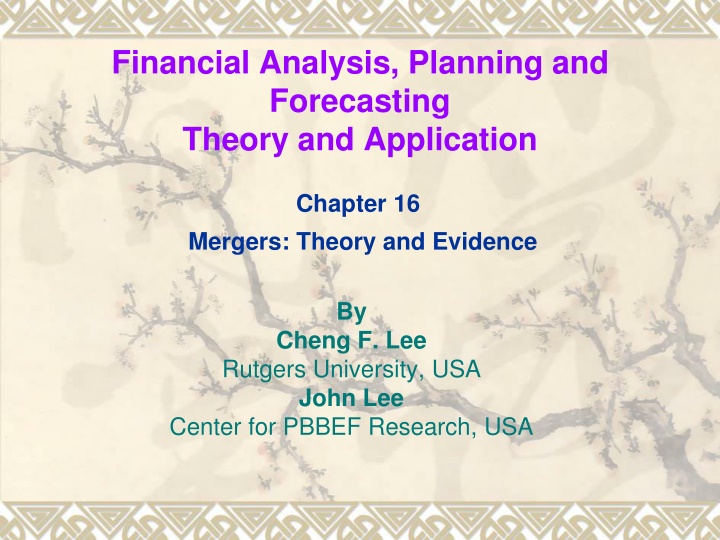
Business Combinations: Theory and Evidence
Explore the theory, evidence, and classification of business combinations in the realm of mergers, acquisitions, and LBOs. Learn about the different types of combinations and the economic relationships involved in corporate restructuring.
Download Presentation

Please find below an Image/Link to download the presentation.
The content on the website is provided AS IS for your information and personal use only. It may not be sold, licensed, or shared on other websites without obtaining consent from the author. If you encounter any issues during the download, it is possible that the publisher has removed the file from their server.
You are allowed to download the files provided on this website for personal or commercial use, subject to the condition that they are used lawfully. All files are the property of their respective owners.
The content on the website is provided AS IS for your information and personal use only. It may not be sold, licensed, or shared on other websites without obtaining consent from the author.
E N D
Presentation Transcript
Financial Analysis, Planning and Forecasting Theory and Application Chapter 16 Mergers: Theory and Evidence By Cheng F. Lee Rutgers University, USA John Lee Center for PBBEF Research, USA
Outline 16.1 Introduction 16.2 Overview of Mergers 16.3 Classification of Business Combination 16.4 Methods of Business Combination 16.5 Merger Accounting and Tax Effects Tax Implications Accounting Treatment of Business Combination 16.6 Economic Theories and Evidence Economic Theories Market Power 16.7 Financial Theories and Evidence Diversification and Debt Capacity 16.8 Summary
16.3 Classification of Business Combination Table 16.1 Largest Mergers, Acquisitions and LBOs: 1980-1995 Acquiring Company Acquired Company Price ($ Billions) Year 1 Kohlberg Kravis Roberts (LBO) RJR Nabisco $25.1 1988 2 AT&T McCaw Cellular Comm. Inc. 18.9 1994 3 Air Touch Communications (merger) US West Inc. 13.5 1995 4 Chevron Gulf Oil 13.3 1984 5 Philip Morris Kraft 13.1 1988 6 Bell Atlantic Corp. (merger) (cellular phone business) NYNEX Corp. (cellular phone business) 13.0 1995 7 Time Inc. Warner Communications 12.6 1990 8 Bristol-Myers Squibb 12.5 1989 9 Texaco Getty Oil 10.1 1984 10 Martin Mirietta Corp. (merger) Lockheed Martin Corp. 10.0 1995 11 Viacom Inc. Paramount Communication Inc. 9.6 1994 12 American home Products Corp. American Cyanmid Co. 9.6 1989 13 Beecham Group Smith Kline Beckman 8.3 1989
16.3 Classification of Business Combination Table 16.1 Largest Mergers, Acquisitions and LBOs: 1980-1995 (Cont d) Acquiring Company Acquired Company Price ($ Billions) 8.0 Year 1981 14 DuPont Conoco 15 Viacom Inc. blockbuster Entertainment Corp. 8.0 1994 16 British Petroleum Standard Oil Ohio (remaining 45% interest) 7.8 1987 17 AT&T NCR 7.5 1991 18 Hoechst AG Marion Merrell Dow Inc. 7.1 1995 19 Upjohn co. Phamacia AB 7.0 1995 20 Matsushita Electric Industrial Co. Ltd. MCA, Inc. 6.9 1991 21 GTE Contel 6.8 1991 22 Kimberly-Clerk Corp. Scott Paper Co. 6.8 1995 23 Bankers Trust New York Corp. Cheska Sporitela Savings Banks (40% of Cesky Investichi Fond and Vynosovy Investichi Fond 6.7 1995 24 Campeau Federated Department Stores 6.5 1988 25 Kohlberg Kravis Roberts (LBO) Beatrice 6.2 1983 26 Merck & Co. Medco Containment Services Inc. 6.2 1993 Source: Mergers & Acquisitions, IDD Inc., Philadelphia, Reprinted with permission.
16.3 Classification of Business Combination Classification by corporate structure. Assume there are originally two firms, A and B. One possible business combination might result in only B surviving. This type of combination is known as a merger, and B is called the acquiring firm and A the acquired firm or target firm. Another type of business combination might result in the formation of a new firm C, which has the assets of both A and B. This type of combination is known as a consolidation. Finally, consider a combination in which A exchanges some of its shares for some of the shares of B. This is called an acquisition; B is the parent and A is the subsidiary. Note that one, both, or neither of the original firms may survive after a business combination. The terms merger, consolidation, and acquisition are often used interchangeably. Classification by economic relationship. Another useful way of classifying business combinations is by the economic relationship of the firms before the combination. If the two firms had performed a similar function in the production or sale of goods and services, then the combination is said to be horizontal. Before a horizontal combination the firms were, or at least had the potential to be, competitors. Another type of combination may involve two firms that are in a supplier-customer relationship. Such a combination is said to be vertical. Finally, a third type of combination may involve firms which have little, if any, product market similarities. These are known as conglomerate combinations. The term conglomerate, however, is generally reserved for firms that have engaged in several conglomerate combinations.
16.4 Methods of Business Combination Table 16.2 Firm Net Income Shares EPS Price P/E A $1,000,000 1,000,000 $1.00 $10 10 B 4,000,000 2,000,000 2.00 40 20
16.4 Methods of Business Combination 5,000,000 5 EPS* = 2,000,000 + 1,000,000ER = 2 + ER, 5 P* = ( 2 + ER)(P / E*) 5 P / E* 40. 2 + ER B
16.4 Methods of Business Combination -2 + P / E* ER . B 8 5 P / E* 10 / ER. 2 + ER A 4 ER P / E* - 2. A
16.4 Methods of Business Combination FIGURE 16.1 The relation between ER and P/E ER ERA ERB I * P/E
16.4 Methods of Business Combination Successful Unsuccessful Bidding Firm 124 48 Target Firm 136 36 Rjt = j+ jRmt + jt (16.1) where Rjt Rmt = Rate-of-return on a value-weighted market index, jt = Disturbance term with E( jt) = 0, j = Measure of the systematic risk of security j, and j = Intercept of the market model for security j. = Rate-of-return on security j over period t,
16.4 Methods of Business Combination TABLE 16.3 Selected companies that received offers in 1981
16.4 Methods of Business Combination TABLE 16.3 Selected companies that received offers in 1981 (Cont d)
16.5 Merger accounting and tax effects Tax implications Taxable Mergers and Acquisitions Nontaxable Mergers and Acquisitions Accounting treatment of business combinations Pooling of Interest Purchase Method
16.5 Merger accounting and tax effects Tax implications Taxable Mergers and Acquisitions On taxable acquisitions, the acquiring company s tax basis in the stock or assets acquired is equal to the amount paid. For the selling firm, the entire gain (or loss) is recognized immediately and is taxable. Nontaxable Mergers and Acquisitions On nontaxable combinations, the seller defers recognition of the gain and the acquiring company obtains the seller s basis for the stock or assets acquired.
16.5 Merger accounting and tax effects Accounting treatment of business combinations Pooling of Interest Purchase Method Firm B Working Capital 100 Net Plant 300 Long-term Debt 50 Equity 350 Firm A Working Capital 50 Net Plant 150 Long-term Debt 20 Equity 180
16.5 Merger accounting and tax effects Firm B-A Working Capital 150 Net Plant 450 Long-term Debt 70 Equity 530 Firm B-A Working Capital (100 -50 + 50) 100 Net Plant (300+150) 450 Goodwill 20 Long-term Debt (50 +20 +150) 220 Equity 350
16.6 Economic theories and evidence Economic theories The literature of economics and finance has advanced many theories to justify business combinations. However, it is unlikely that any business combination occurs because of a single reason -- several objectives may act together to motivate the activity. Market power Another economic justification for mergers involves the issue of market power and market share. These issues are the crux of the arguments that the Justice Department advances against mergers. The basic defense is that mergers do not result in an increase in the level of competition; but that they are only organizational changes and should leave competing forces the same.
16.7 Financial Theories and Evidence Diversification and debt capacity VAB= VA+ VB, Z = 0.012x1+ 0.014x2+ 0.033x3+ 0.006x4+ 0.99x5, where Working capital, Total assets Retained earnings, Total assets Earnings before interest and tax, Total assets Market value equity, Book value of debt Sales . Total assets = x 1 = x 2 = x 3 = x 4 = x 5
16.7 Financial theories and evidence k k k k K k R + it e (16.2) b b R = a + R + it mt It i 2 e, (16.3) g + g b + R = jt jt 0t 1t jt cov ( , ) R R j m = j , var ( ) R m
16.7 Financial theories and evidence U (p = 1, 2, ... 20) (16.4) g + 1t g b R = 0t + pt pt p(t-1) b , (16.5) 0t g - 1t g e = R - jt jt jt RIt- Rft= I+ BI(Rmt- Rft) + EIt. (16.6)
16.7 Financial theories and evidence Eit= CiEIt+ it. (16.7) Rit- Rft= i+ i(Rmt- Rft) + it = i+ i(Rmt- Rft) + Ci( It- I) + it. (16.8) Eit= i+ it. (16.9)
16.7 Financial theories and evidence In order to determine the hypothetical dividends and stock price, Shick and Jen use a common-stock valuation model (see Shick (1972) and Bower and Bower (1969)) based on Gordon s model: P = D e (k - g), (16.10) ln P = B0+ B1ln D + B2ln (gs/g1) + B3ln g1+ B4ln h + B5ln V + B6ln A + B7ln F + (16.11)
16.8 Summary Summary In this chapter, we have reviewed historical merger and acquisition activities in United States and other countries. Then, we have discussed accounting treatment of merger and acquisition. In addition, we also discussed the method to evaluate and forecast merger and acquisition activities. There are many reasons why firms engage in business combinations and there is much we can learn from empirical research. Mergers and acquisitions provide a rich area for study of the firm because they allow specific events to be analyzed in light of their capital-market effects. An integration of accounting, microeconomics, and financial theory has the potential to provide a more complete theory of the firm.
Appendix 16A. Effects of divestiture on firm valuation ( ) = + G A B 0 V V V t T 16.A.1 t t t where = = = G Value of combined firm , V G t A Value of division , V A t B Value of division . V B t
Appendix 16A. Effects of divestiture on firm valuation = + G A B V V V 16.A.2 0 0 0 A G D D 16.A.3 0 0 Where = = G Value of G's debt, D 0 A Value of A's debt, D 0
Appendix 16A. Effects of divestiture on firm valuation + 16.A.4 A B G S S S 0 0 0 where = = = A Value of 's Equity, A S 0 B Value of 's Equity, B S 0 G Value of 's Equity. G S 0
Appendix 16B. Exchange Ratio One of the more common results of negotiation is the agreement to exchange shares of common stock. In these cases, the determination of the price paid for the acquired firm is actually the determination of an exchange ratio. Larson and Gonedes (1969) presented a model for exchange ratio determination. Their analysis of exchange ratios involves making assumptions about the pre- and post- combination earnings streams and P/E (price-earnings) ratios. For example, assume the information of net income, shares, earnings per share (EPS), price per share (PPS) and P/E ratio about firms A and B as shown in Table 25-1. Let ER be the exchange ratio, which is defined as the number of traded shares of firm B divided by the number of traded shares of firm A. The earnings per share after the combination is given by
Appendix 16B. Exchange Ratio and the post-combination price is where P/E* is the post-combination P/E ratio. Table 25-1 Firm Net Income $1,000,000 4,000,000 Shares EPS PPS P/E Ratio 10 20 A B 1,000,000 2,000,000 $1 2 $10 40
Appendix 16B. Exchange Ratio For the shareholders of firm B to be as well off after the negotiation as before, then P* PB; that is, This will occur when Assume that P/E* is 18, then the exchange ratio is .25 or 1/4. In other words, each share of A s stock is exchanged for 1/4thof B s stock.
Appendix 16B. Exchange Ratio And for the shareholders of firm A to be as well off, then P* PA/ER, or which will occur when
Appendix 16B. Exchange Ratio Hence, the acceptance of the negotiated exchange ratio depends on expectations about the post-combination P/E ratio. Graphically, these requirements imply that the range of negotiation lies in the area labeled I in Figure 25-2. The agreed- on exchange ratio will depend on the relative bargaining positions of the two firms1. [1]An empirical test of the exchange ratio model has been conducted by Conn and Nielson (1977) on a sample of 131 combinations over the period from 1960 through 1969. They found that the exchange ratio model was supported by the tests, but that there were cases when the shareholders of the acquired firm benefited at the expense of the shareholders of the acquitting firm.
Appendix 16B. Exchange Ratio Now we will define general equations for the example discussed in the previous section. Assume Firm A and Firm B are the acquired firm and the acquiring firm, respectively. Let the exchange ratio (ER) be defined as the number of traded shares of Firm B to be exchanged for the one traded share of Firm A. LG defined the post-combination price (p*) as: (16B-1)
Appendix 16B. Exchange Ratio where NIAand NIBrepresent net income for Firm A and Firm B, respectively, and NAand NBare the number of shares outstanding for Firm A and Firm B, respectively. PE* is the post-combination price/earnings ratio. By comparing p* with price per share before the combination of Firm A (PA) and Firm B (PB), we find the following exchange ratio will affect the shareholders of both Firm A and Firm B as follows:
Appendix 16B. Exchange Ratio (i) The shareholder of Firm A are as well off after the combination as before if: (16B-2) (ii) The shareholder of Firm B are as well off after the combination as before if: (16B-3)
Appendix 16B. Exchange Ratio EXAMPLE 25.1 Exchange Ratio Determination Q: Related financial information prior to a business combination presented as follows: Firm Net Income Shares A $1,000,000 1,000,000 B 4,000,000 2,000,000 EPS $1.00 2.00 Price $10 40 P/E 10 20 If the P/E ratio after the business combination is 18, what is the exchange ratio that will make the shareholders of Firm B as well off after the combination as before? For any P/E greater than or equal to 10, the shareholders of Firm B will always be better off. Therefore, the only P/Es of interest are those less than 20.
Appendix 16B. Exchange Ratio EXAMPLE 25.1 Exchange Ratio Determination A: Substituting the above information in Equation 25-3, we obtain: = 2.25-2 = .25, or If the exchange ratio is 1/4 , then the shareholders of Firm B will be as well off after the combination as they were before. This result is consistent with the result presented before.
Appendix 16C. The Tender Offer Another method used in business combinations is the tender offer, in which the acquiring firm makes its offer directly to the shareholders of the firm it wishes to acquire. Tender offers are usually made through the financial press. The acquiring firm offers to pay a fixed amount per share to each shareholder who then tenders his or her shares. The amount per share is usually set far enough above the current market price to entice the shareholders of the target firm. Tender offers are often made when negotiations break down or as a surprise move by the acquiring firm to catch the management of the target firm off guard. Tender offers may take the form of either a cash or stock bid for a block of shares of the target firm. In many large corporations, effective control can be gained with ownership of less than 50 percent of the shares.
Appendix 16C. The Tender Offer Hence, an acquiring firm can make a tender offer, gain control, and then proceed with negotiation for the remainder of the shares. Tender offers have generated a new vernacular. Some of the frequently encountered terms are as follows: White knights. In 1982, 29 major firms were targets of hostile takeover bids, and only 12 of these firms were able to resist the unwelcome bids. Of these 12 firms, only 2 were saved by white knights, which are firms that offer friendly takeover terms. Shark repellents. These are antitakeover amendments firms use in their corporate charters to protect themselves from unfavorable takeovers. Two such strategies are (1) supermajority rules, which generally require 95 percent approval for tender offers, and (2) fair-price amendments,
Appendix 16C. The Tender Offer which require that the stock be acquired at essentially one price. Fair-price amendments help shareholders to protect against two-tier acquisitions in which the acquiring firm buys one block of stock at a high price and then the remaining shares at a substantially lower price. Pac-man strategy. In this strategy, the target firm tries to take over the hostile bidder. Golden parachutes. Companies often provide their top executives with substantial severance benefits, or golden parachutes, in the event of a hostile takeover. Arguably, these benefits may have some economic justification because top management faces a dilemma in light of a hostile threat. If management resists the takeover attempt, even if it believes such resistance is in the shareholders
Appendix 16C. The Tender Offer best interests, the top managers are likely to be dismissed if the attempt is successful. Hence, with the golden parachute there is some incentive to acquiesce to hostile but strong suitors. State and federal laws place several legal requirements on tender offers. The bids for shares must remain open for at least 20 days. Moreover, shares that are tendered during this period may be withdrawn during the period. And if the original offer price is raised, shares tendered under the original offer are also entitled to the higher price. Also, after one firm makes a tender offer, other firms may also enter the battle for a target firm.








